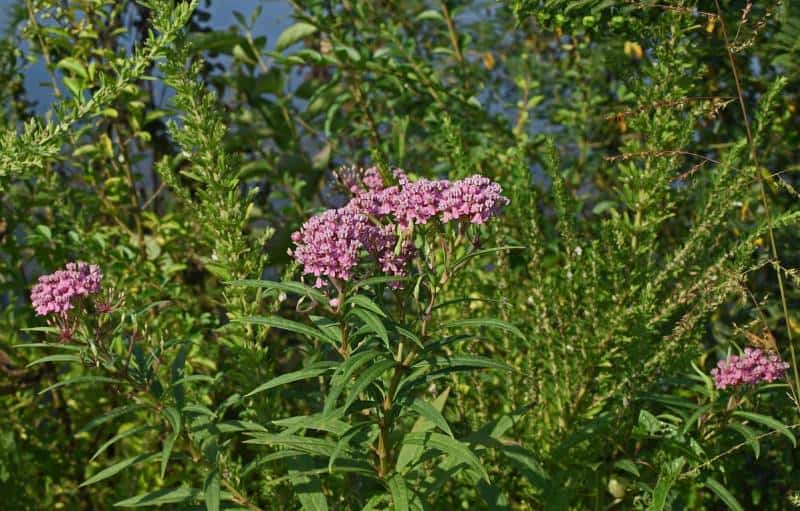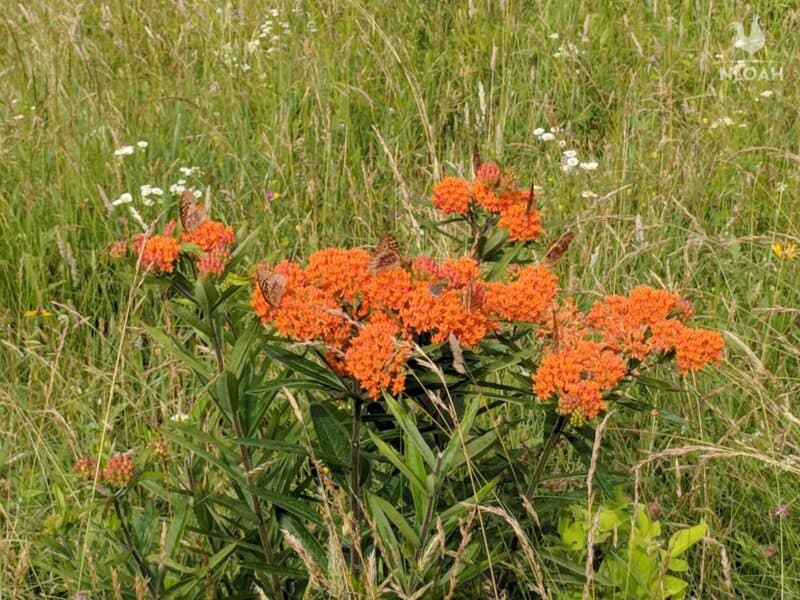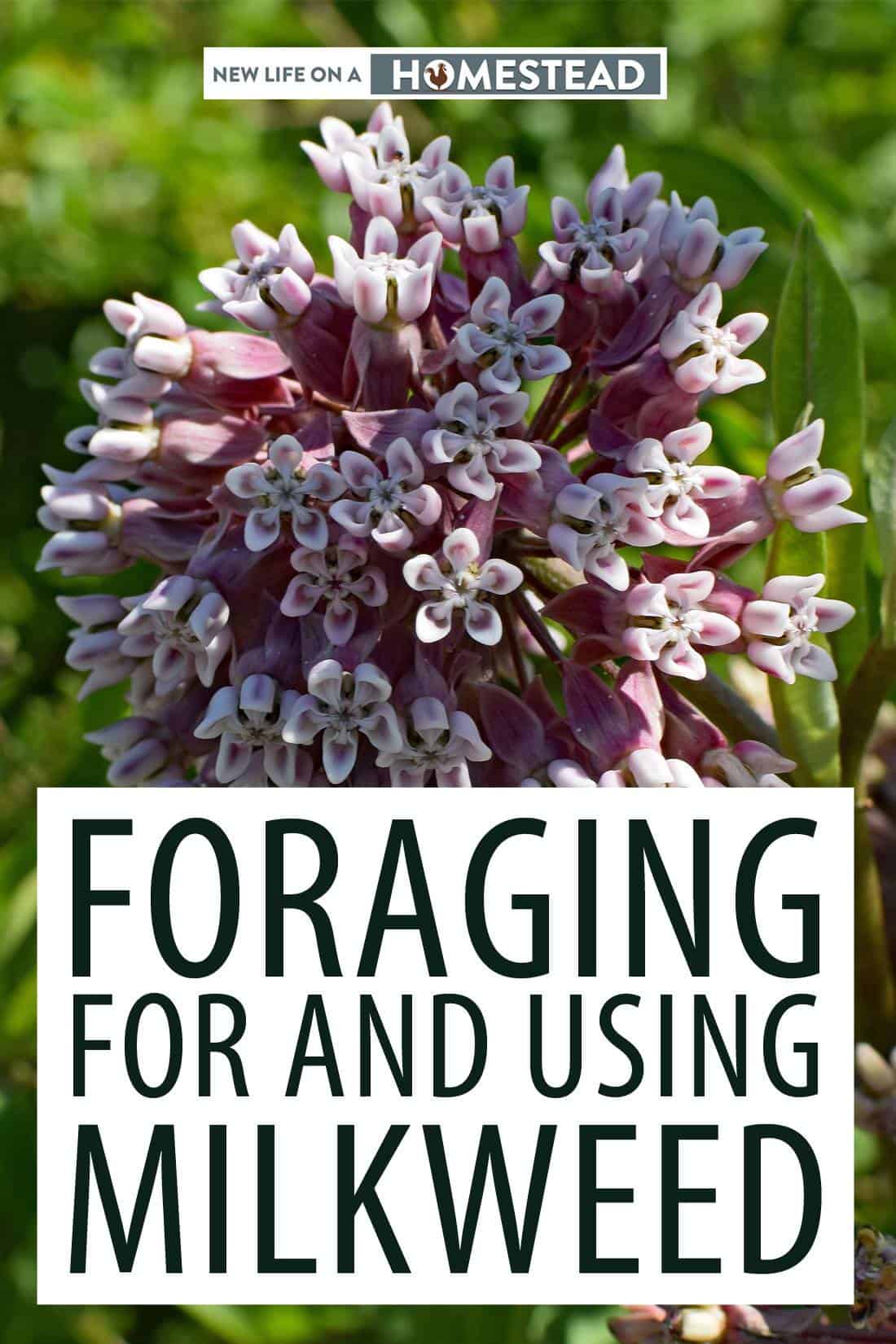The flowering perennial milkweeds (falling under the genus Asclepias), grow all throughout the United States. Milkweed flowers range from soft pink, to green, to scarlet, and many colors in between.
These plants aren’t just nice to look at. Milkweed is the only plant on which monarch caterpillars feed, making it critical for the survival of the iconic butterfly species.

Milkweed plants are complex and crucial to the environment. They are not hard to identify once you know what to look for, and the milkweed you forage will delight dinner guests.
If you are a homesteader and want to help restore the monarch butterfly population in your area – or just have your own supply of these tasty native plants on hand for yourself – make milkweed the latest addition to your garden, or harvest it rom the woods and fields around you.
This is a plant that can do it all. Here’s what you need to know about milkweed.
General Info
There are approximately 115 Asclepias species growing across North America. They range as far south as Texas, and as far north as the Quebec region of Canada.
Different species
Common milkweed (Asclepias syriaca L) is the most well-known and abundant species. It has a soft pink hue, and the flowers grow in spherical umbels. This milkweed usually grows between 3-5, ft but has been known to grow as tall as 8ft!
You can find it growing in the United States and southern Canada east of the Mississippi. It spreads aggressively, so you’d rather forage than grow milkweed in your garden.
Swamp Milkweed (Asclepias incarnata) has bright pink and purple flower clusters that foragers and butterflies alike love. This perennial isn’t as tall as its common cousin, it usually only reaches 2-4 ft (0.6 to 1.2 meters) in height.
Its Latin species name derives from the word for “flesh colored.” While its English moniker comes from its habitat. As the name implies, swamp milkweed grows in moist climates, such as swamps and marshlands. You can also find it near flooded plains, lakes, and ponds.

Butterfly Milkweed (Asclepias tuberosa) is small, but hard to miss with those vibrant orange flowers. This perennial only grows up to 1-2ft tall. It grows in canyons, open woods, and hillsides. You can find it almost anywhere in Texas except for Hill Country.
This drought tolerant milkweed thrives in sandy, dry soil with good drainage. This milkweed gets its name from being a favorite among butterflies. Among the First Nations, butterfly milkweed is also known as Pleurisy Root, because natives used to chew the roots to cure pleurisy.
Biology
Milkweed owes its nickname to the milky latex substance it exudes from damaged cells. The tall plant grows between 3-6 feet tall. Common milkweed’s spherical flowers are called umbels.
Umbels bloom between late June and July, while the pods open in late fall. Fall winds and insects preparing for hibernation disseminate seeds and pollen.
Ecology/Keystone Species
Common milkweed is a keystone species in ecosystems across North America. A keystone species is a species on which other species depend. Without the keystone species, the whole ecosystem would deteriorate. Milkweed provides nectar for bees, wasps, and butterflies.
As milkweed disappears from cities and suburbs, so does the butterfly population. Although not yet classified as an endangered species, monarch butterflies are being considered due to the rapid decrease in the population size.
Planting milkweed has become an important agricultural practice in restoring pollinators.
How to Identify Milkweed
Foraging wild milkweed is much more common than planting it. Milkweed grows abundantly in almost every state, so it shouldn’t be hard for you to find. Here are some easy identifiers.
Patterns Method
Thomas Eppels invented the patterns method in his book, Botany in a Day. This method uses a filing system based on patterns in which milkweed grows.
- Milkweed produces opposite or whorled leaves. There are five petal-like leaves known as sepals and five fused petals.
- The corona at the top of the flower like a crown has five inward facing forms.
- Within the corona there are five stamens (male) attached to the ovary.
When you think of milkweed, remember the number five. Five sepals, five petals, five spikes on the corona (crown), and five stamens. Although the colors of milkweed vary, the patterns remain consistent across species.
Don’t Forget how Milkweed Got its Name
Remember, milkweed was dubbed so because of the milky sap injured leaves secrete. If you want to confirm the plant you found is milkweed, tear a small piece of a leaf off and watch for the secretion.
But to be on the safe side, hold the leaf away from your face, and hold the leaf at the bottom, away from the tear. The sap can cause irritation on the skin and in the eyes.
Know Where to Look
Your region’s climate will determine which milkweed will be easiest to find. If you live in a warm, wet environment such as Florida, look for the citrusy orange flowers of swamp milkweed.
If you are in the Midwest, look for common milkweed in meadows, prairies, or at the edges of forests. Since milkweed needs hours of direct sunlight every day, you won’t find milkweed growing in the forest.
Milkweed grows in meadows, prairies, on the side of the road, and along fences. If you live in a quiet area, look along roads that don’t see a lot of traffic. If you see butterflies fluttering around roadside vegetation, you have most likely found milkweed.
Identifying Imposters
There are many plants that bear a striking resemblance to milkweed, and thus confuse novice and experienced foragers alike. There are a few famous imposters.
Dogbane
One of these imposters is dogbane (Apocynum cannabinum). Dogbane grows throughout the eastern United States and southern Canada, the same regions as many milkweed varieties.
The two plants don’t just look alike and grow in the same regions. What can also trick foragers is the fact that dogbane, like milkweed, secretes a milky sap from damaged leaves.
Dogbane flowers grow in smaller clusters, and are usually white and green. Additionally, common milkweed has a hairier stem. Dogbane does not attract butterflies. And while dogbane fibers can make sturdy rope, you won’t want to serve it at the dinner table.
Pokeweed
Another common imposter is pokeweed. Pokeweed looks like milkweed, and has a similar name, for double the confusion. Pokeweed grows in similar locations as milkweed too.
You are likely to find pokeweed in pastures, along roads and fences, and even under power lines. You’ll most likely find it on the west coast, southwest, or as far northeast as Maine.
However, pokeweed flower petals do not face downwards. Pokeweed also grows small berries that you will not find on any milkweed.
If you do find pokeweed in the wild, do not eat the berries; they are toxic and so much as touching them can irritate your skin. Save these berries for songbirds who are hungry and immune to the toxin.
Recipes
Butterflies aren’t the only creatures who find milkweed tasty. Foraging chefs love milkweed for its versatility and non-bitter taste. The shoots, pods, and leaves of milkweed can be incorporated into a wide variety of recipes.
That being said, do not eat raw milkweed. Raw milkweed is poisonous. The shoots, pods, and leaves become edible (and delicious) when they are cooked.
Milkweed Shoots
You can cook milkweed shoots the same way you would cook asparagus. This isn’t surprising. Asparagus, like milkweed, grows alongside roads and is popular among foragers. Like asparagus, you want to break off milkweed cleanly. You also want to use young shoots.
Blanche the milkweed shoots for thirty seconds in boiling salted water. Transfer the shoots to a buttered-up pan and sauté carefully. You don’t want the shoots to become mushy.
Don’t cook them for more than a minute or so. You can then transfer the milkweed to the plate, top with some salt and pepper, and enjoy!
Alternatively, cut the shoots into smaller pieces and sauté with other vegetables, such as carrots, peppers, and onion, for a cooked veggie blend.
Note: If you are trying milkweed shoots for the first time, don’t overindulge. It’s best to start off with a small portion.
Milkweed Pods
If you have the taste for something spicy, try buffalo style milkweed pods. This recipe is a great vegetarian alternative to buffalo wings. Not only do these pods have the same kick as buffalo wings, but they are also quick and easy to make.
Mix together the breadcrumbs, flour, garlic powder, and spices (paprika, oregano, cayenne, and turmeric). In a separate bowl, mix the egg, almond milk, and water. Once combined, pour the wet mixture into the dry one and stir until combined.
Drop the pods into the batter and coat well. Place the pods on a baking sheet lined with parchment paper and cook for 15-20 minutes at 350℉ (180℃).
Remove the crisp pods from the oven. Evenly coat the pods with your favorite hot sauce and cook for another ten minutes. Let the pods cool and enjoy!
Edible Leaves
If you’re looking for a real culinary challenge, try making your own milkweed leaf pasta dough.
- Blanche the leaves in lightly salted boiling water for thirty seconds.
- Refresh in an ice bath, and then drain.
- Chop the blanched leaves as finely as you can
- Puree them a blender with the yolk of one egg.
- Combine the flour, salt, and puree in a bowl.
- Use a hand mixer with a dough hook until the mixture is smooth.
- Let the dough rest for thirty minutes.
- Divide the dough into quarters and roll each fourth on the pasta machine until they are very thin.
- Cut the flattened dough into half inch fettuccine noodles.
- Toss the noodles in semolina flour to prevent sticking and store in the fridge (only up to three days) or freezer.
Planting Milkweed
Milkweed is a relatively low maintenance garden plant. It adapts well to soil, and does not need frequent watering. However, if you want to plant milkweed, there are some important factors to consider.
More and more conservationists are advocating for gardeners to plant milkweed. Planting milkweed helps restore butterfly populations by providing sustenance and a place to lay eggs.
What to Consider
If you have any livestock, please be careful when planting milkweed. Milkweed is poisonous to children, pets, and livestock when consumed in large doses.
Additionally, if you want to grow milkweed, find out which species is native to your area. This way, your garden will most likely already provide the necessary conditions for the flowers to thrive.
The best time to plant milkweed is in the fall. The winter freeze, and spring thaw soften the coating on the seed so the embryo can grow. Once the seed germinates, it will need a lot of sunshine.
Most milkweed grows in areas with direct exposure to the sun. Again, check which milkweed are native to your area, so that you know which species will be able to thrive in your region’s weather.
Dispelling Common Myths
Contrary to popular belief, not all milkweeds are invasive species. Although common milkweed spreads quickly through a garden, swamp milkweed is not invasive.
The spread of common milkweed is easy to prevent; just remove the immature seed pods. You may also want to grow common milkweed at the outskirts of your garden, rather than the center. Swamp milkweed is the most popular choice among gardeners.
Medicinal Uses
Asclepias was named after Asclepius, the Greek God of medicine, so, it’s no surprise that milkweed became famous among Native Americans and English colonists for its healing properties. The First Nations found many uses for Asclepias.
Even today, milkweed extracts are used in medications, and medical doctors attest to many of the flower’s healing properties.
Members of the Lakota tribe used green milkweed to treat diarrhea in children. While members of the Blackfoot tribe used the same species to treat sore throats. An infusion of common milkweed juice and leaves from creosote bush form a poultice to draw out poison.
The juice of milkweed heals warts. The First Nations first discovered this, and even today milkweed juice is an ingredient in over-the-counter drugs.
Some speculate that the cardiac glycosides from the plant contain natural poisons that kill warts. These are the same natural poisons that make butterflies taste bad to predators.
Ready to Start Foraging?
Milkweed has so many benefits, that foraging becomes an exciting prospect, not to mention that milkweed is even something of a war hero.
During World War II, the buoyant fibers found in milkweed floss were used as stuffing for life jackets for soldiers. Seamen and aviators who risked falling into sea counted on these life jackets, and the floss inside, to keep them from drowning until they could be rescued. Children all across America gathered millions of pounds of milkweed pods to aid in the war effort.
Remember your fives when foraging, and don’t be tricked by hairless dogbane stems or pokeweed berries.
If the foraging gets tough, let the butterflies be your guide. Take your milkweed home and prepare a nice family dinner.
If you want to grow milkweed to turn your garden into a butterfly sanctuary, start with seeds from a greenhouse rather than foraged milkweed.

When Tom Harkins is not busy doing emergency repairs to his 200 year-old New England home, he tries to send all of his time gardening, home brewing, foraging, and taking care of his ever-growing flock of chickens, turkey and geese.

As to the very last sentence in your article, could you please give the reason why? I’ve just found milkweed for the first time in my area and was very excited to transplant some for myself